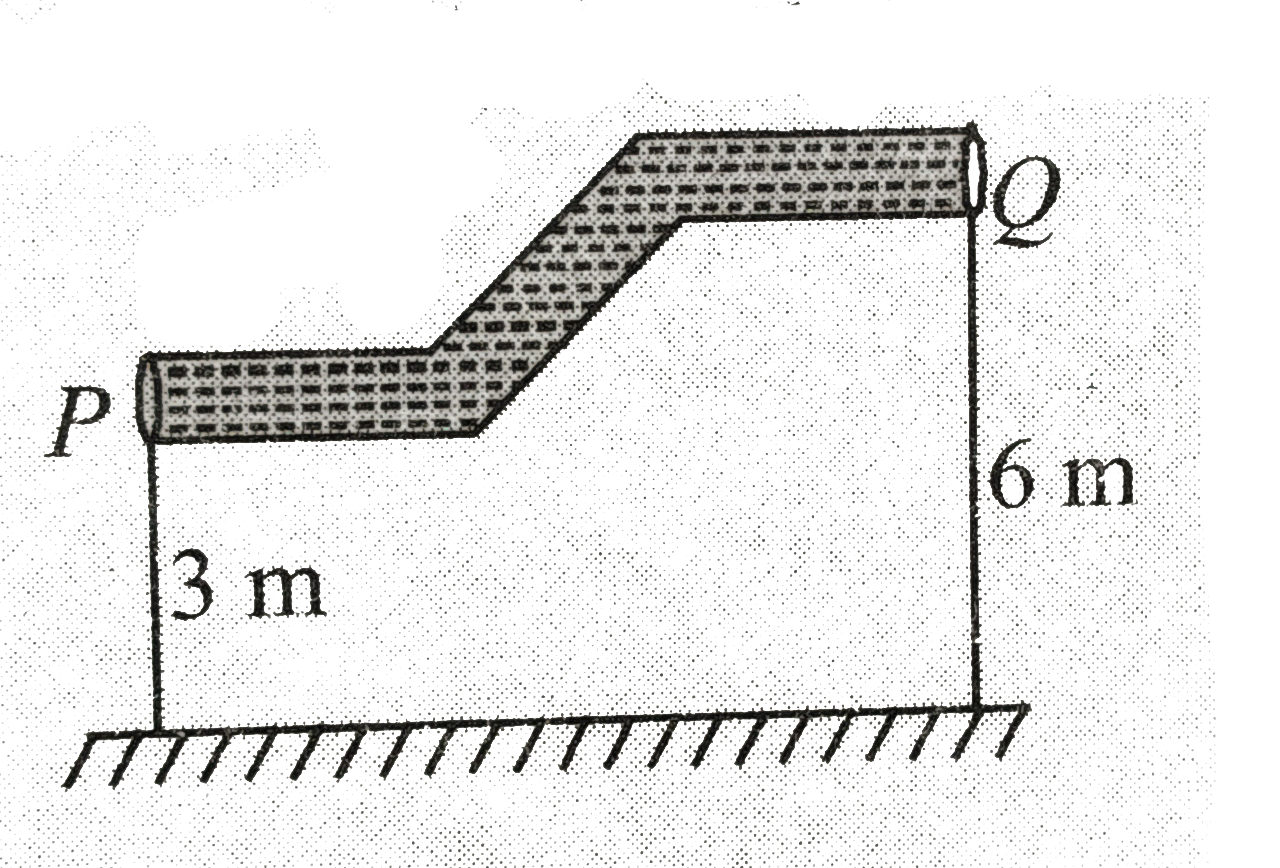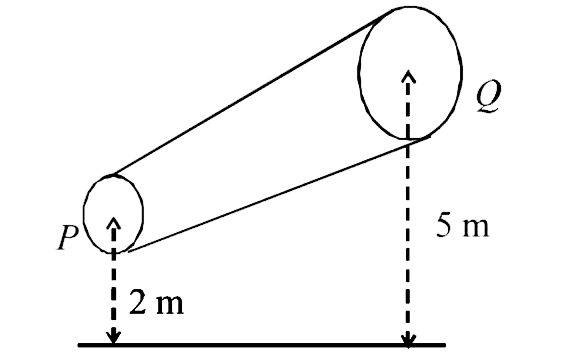A non viscous liquid of constant density 103kg/m3 flows in stream line motion along a vertical tube PQ of variable cross-section. Height of P and Q are 2m and 2.5m respectively. Area of tube at Q is equal to 3 times the area of tube at 'P'. Then work done per unit volume by pressure as liquid flows from P and Q. Speed of liquid at 'P' is 3m/s.

(a)2000J/m3
(b)1000J/m3
(c)1575J/m3
(d)9000J/m3
The correct Answer is:B
P1−P2=12ρ(v22−v21)+ρg(h2−h1)
=12×103(12−32)+103×10(0.5)
=−4×103+5×103
=1000J/m3
Topper's Solved these Questions
- JEE MAIN REVISION TEST - 1 | JEE - 2020 Book:VMC MODULES ENGLISHChapter:JEE MAIN REVISION TEST - 1 | JEE - 2020 Exercise:PHYSICS ( SECTION 2)
Explore 5 Videos
- JEE MAIN REVISION TEST - 1 (2020)Book:VMC MODULES ENGLISHChapter:JEE MAIN REVISION TEST - 1 (2020)Exercise:PHYSICS - SECTION 2
Explore 5 Videos
- JEE MAIN REVISION TEST - 10| JEE -2020Book:VMC MODULES ENGLISHChapter:JEE MAIN REVISION TEST - 10| JEE -2020Exercise:PHYSICS (SECTION 2)
Explore 5 Videos
Similar Questions
A non-viscous liquid of constant density 500kg/m3 flows in a variable cross-sectional tube. The area of cross section of the tube at two points P and Q at heights of 3m and 6m are 2×10−3m3 and 4×10−3m3, respectively. Find the work done per unit volume by the forces of gravity as the fluid flows from point P to Q.

View SolutionA non-viscous liquid of constant density 1000kg/m3 flows in a streamline motion along a tube of variable cross section. The tube is kept inclined in the vertical plane as shown in Figure. The area of cross section of the tube two point P and Q at heights of 2 metres and 5 metres are respectively 4×10−3m2 and 8×10−3m2. The velocity of the liquid at point P is 1m/s. Find the work done per unit volume by the pressure and the gravity forces as the fluid flows from point P to Q.

View SolutionWater flows through a horizontal tube of variable cross section.The area of cross section at A and B are 4 mm2and2mm2 respectively. If 1 cc of water enters per second through A find
a) The speed of water at A
b) the speed of river at B
c) the pressure difference PA−PB.

View SolutionWater flows through a horizontal tube of variable cross-section. The area of cross section at A and B are 4mm2and2mm2 respectively. If 1 cc of water enters per seconds through. A find a. The speed of water at A, b. the speed of river at B and c. the pressure difference PA−PB.

View SolutionWater flows in a stream line manner through a capillary tube of radius a. The pressure difference being P and the rate of flow is Q. If the radius is reduced to a4 and the pressure is increased to 4P. then the rate of flow becomes
View SolutionA point source emits sound equally in all directions in a non-absorbing medium. Two point P and Q are at distance of 2m and 3m respectively from the source. The ratio of the intensities of the wave at P and Q is :
View SolutionAn ideal liquid (water) flowing through a tube of non-uniform cross section area at A and B are 40cm2 and 20cm2 respectively. If pressure difference between A & B is 700 Nm2 then volume flow rate is

View SolutionThere are two holes on a water tank as shown in figure. Area of hole 2 is two times that of area of hole 1. Suppose v is the speed of liquid coming out and Q the volume of liquid flowing per second. Then

View SolutionThree particales P,Q and R are placedd as per given Masses of P,Q and R are √3m√3m and m respectively The gravitational force on a fourth particle 'S' of mass m is equal to
 .
.
View SolutionA liquid of density 103kgm3 and coefficient of viscosity 8 xx10^(-2) decapoise is flowing in a tube of radius 2 cm with speed 2 m/s. The. Reynold’s number is
View Solution

